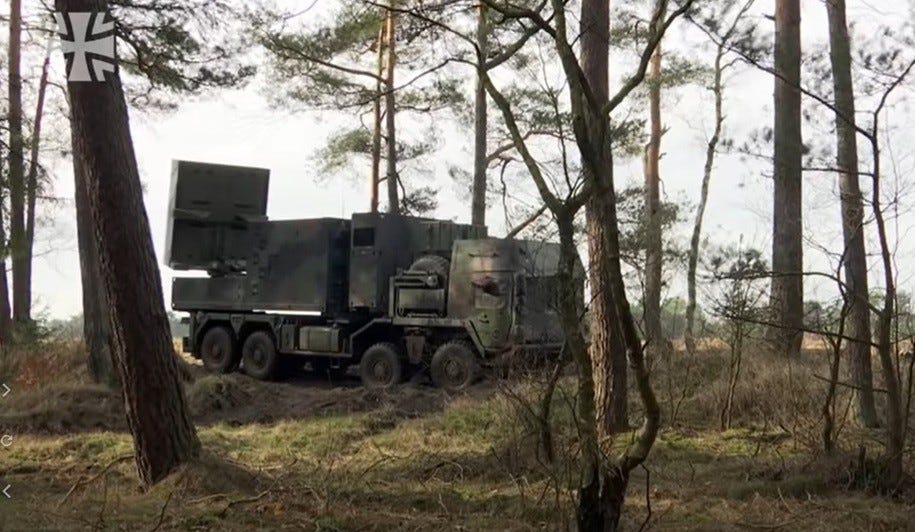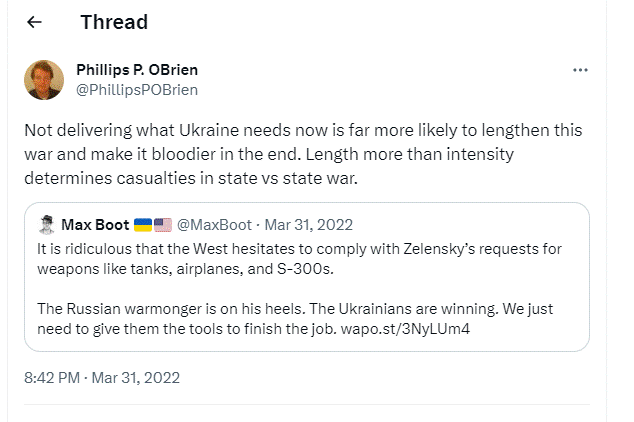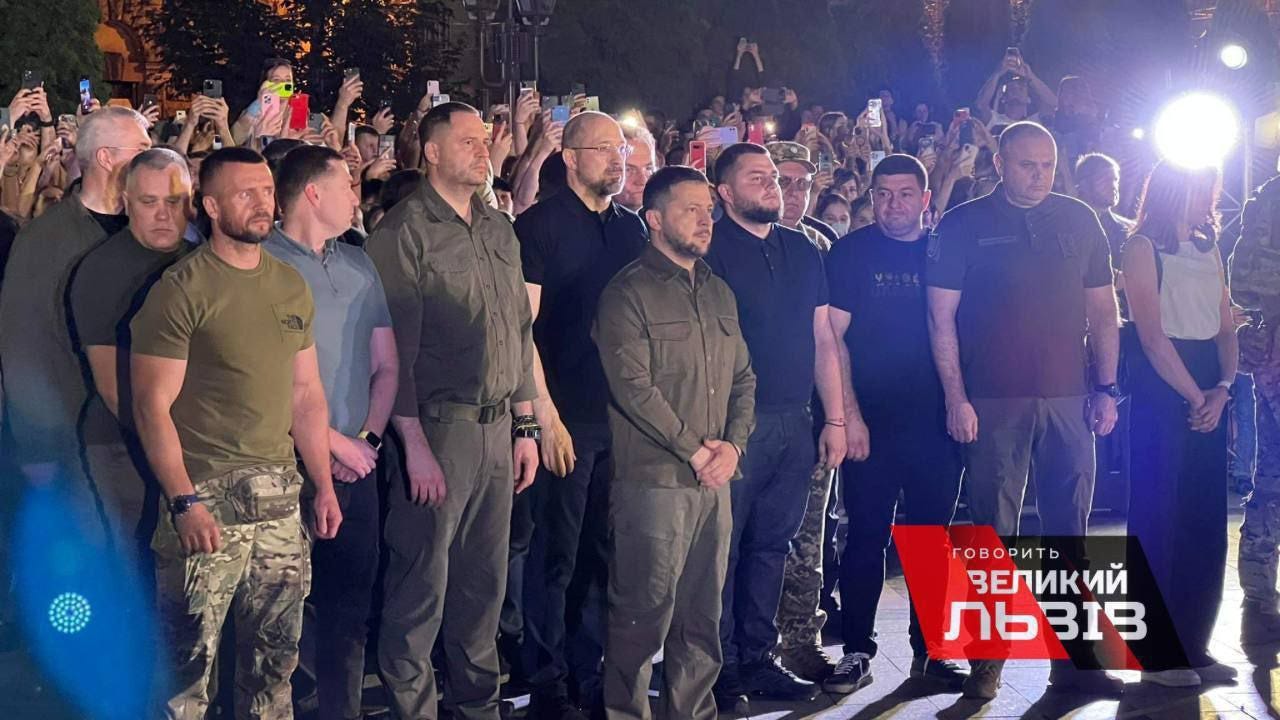In battling Russia's invasion of Ukraine, the defense has done better than the offense.
The two exceptions - the Ukrainian victories at Kharkiv and Kherson last year - came when Ukraine, evaluating the intelligence it had, realized that attacking Russian logistics was essential to weakening the enemy. And that is what is happening again: Ukraine has adapted, ending the head-on armored assaults of the first week, and now concentrating on eliminating both Russian logistics and artillery capabilities. This will likely continue until the other side is severely weakened. JL
Phillips O'Brien reports in his substack:
It is worth reflecting on how Ukraine has fought so well for its freedom, from being written off by most analysts, to now having the initiative in liberating its territory. After the opening ten days, Ukraine changed tactics and concentrated on taking out Russian artillery/MLRS systems and supporting structures, including ammunition depots. Because war is so dangerous for the offensive side, and Ukraine doesnt want to waste its forces like the Russians did at Bakhmut they must weaken the Russians before advancing. (And) cluster munitions can be extremely effective against Russian forces in defensive lines.Well this was a week where the line only moved a little bit in a few places—the Ukrainians seemed to make most of their advances around Bakhmut, but they also made some around Zaporizhzhia, and yet it was a week full of news, with some very important indications of where the war is heading (and what the future might look like). I’ve identified four points that are worthy of discussion—but the way things are going, there could be another one this morning.
Before that, it is worth noting that it is now been 500 days since the Russian full-scale invasion of February 24, 2022. Though that seems like ages ago, its actually a short period in wars like this (large state wars). I sincerely hope that this war is over before another 500 days pass, though I would think if Putin stays in power, we will see fighting of some sort until late 2024 (when the US presidential election occurs). That means we could be only halfway through this.
That being said, it is worth reflecting on how Ukraine has fought so well for its freedom, from being written off by most analysts (honest to God, most were wondering whether Ukraine could even muster an insurgency, let alone outfight Russia in a conventional war), to now having the initiative in liberating its territory.
The New Battle of Kherson
I wrote a substack earlier this week saying that the Ukrainian counteroffensive had entered a distinct second phase. Basically, the Ukrainians had attempted a operational maneuver breakthrough but the reality of modern war reared its head. Vehicles such as tanks are extremely vulnerable to a range of systems (mines, hand-helds, UAVs, artillery, etc) and pushing significant force forward in vehicles without command of the air is impossible.
After the opening ten days, however, Ukraine changed tactics and seems to have concentrated overwhelmingly on taking out Russian artillery/MLRS systems and their supporting structures. This includes their ammunition depots (a number of large ones went up in the last week, counterbattery radars, EW, etc).
The focus on Russian artillery is clear from Ukrainian claims of destruction. Basically the daily rate in the last few weeks is almost 200% larger than it has been over the last 500 days. That does not happen by accident.
What this new phase shows is that both this war, and Ukrainian decision-making, is following a course that was first forged in the liberation of Kherson Oblast (right bank of the Dnipro) last Autumn. At first Ukraine did attempt an assault on Russian lines in Kherson and, in a way very similar to what we just saw in Zaporizhzhia in June, they made slow progress and suffered losses. At that time the Ukrainians dialled down the direct assaults to save resources and limit casualties, and identified the Russian systems that they needed to destroy to succeed. In this case it was the bridges (and later pontoons) that were carrying supplies across the Dnipro to Russian forces. What the Ukrainians did was spend months hammering these supply lines (destroying the bridges) which eventually forced the Russians to pull out of the right bank entirely in November.
What Ukraine is doing now is similar intellectually but even more difficult (they dont have rivers to aid them by providing specific targets). They have identified what they need to neutralize on the Russian side to succeed, and now they need to try and take those outs. They are starting clearly by making Russian artillery a very high priority. They will probably stay on that for a while. When they feel they have done what they can here, they will switch to attacks on Russians forces in the lines.
This will take time—even months. Because war is so dangerous for the offensive side, and Ukraine doesnt want to waste its forces like the Russians did at Bakhmut for instance, they must proceed methodically to weaken the Russians before advancing. Its also the only Ukrainian option—because of the specific way that they have been armed. This brings up the next point.
Cluster Munitions
This week the Biden Administration released another list of military aid for Ukraine, and it contained, for the first time, cluster munitions (as well as a signficant amount of other aid to help Ukraine with the counteroffensive. The Cluster Munitions, if you are interested, are the DPICM rounds on the list.
https://www.defense.gov/News/Releases/Release/Article/3451570/biden-administration-announces-additional-security-assistance-for-ukraine/
If you want to read more about them, you can start here.
https://www.popularmechanics.com/military/weapons/a44465526/why-is-the-us-sending-ukraine-cluster-munitions/
Now the Biden administration clearly did not want to make this decision. The Ukrainians have been asking for such munitions for a while, for the precise reason that they should be extremely effective/deadly to Russian forces in their defensive lines. Cluster munitions, as they are made up of large numbers of smaller explosives that can blanket a large area, can be extremely effective.
However, because of their controversial nature, the Biden Administration held off until now (though it can be said that the Turkish government might have supplied some previously). Why did the Biden Administration change position now? Because they have armed Ukraine in a specific way that makes a long, summer campaign necessary.
Ukraine was not provided the longer range systems (ATACMs, F-16s, etc) needed to degrade Russian forces enough before the counteroffensive. Thus Ukraine has been forced into this long summer getting ready for more direct assault. That both means Ukraine will need much more ammunition, but also its being faced with better prepared Russian forces. The ammunition question is one that both President Biden and National Security Adviser Sullivan (the big guns were wheeled out to defend this decision) mentioned publicly.
https://www.nytimes.com/2023/07/07/us/politics/ukraine-cluster-munitions-biden.html
In other words, the Administration was forced into this decision because of the way it deprived Ukraine of more effective systems earlier. Its a direct result of their decisions to hold back (out of fears of escalation one presumes) from giving Ukraine better systems earlier. It points out a truism for this and most wars, that actually lengthening them makes things far worse. In March 2022, I argued this publicly in saying it was much better to arm Ukraine effectively as soon as possible—as it would save lives and shorten the war.
We are now seeing the result of that decision to try and limit aid to certain stages (first yes you can get artillery, but no tanks; then you can get tanks, but no aircraft; then you can get aircraft—but we will slow the process as much as possible; and of course no ATACMS ever). This has made the war longer and nastier.
Maybe now people will understand that (it will be interesting to see if ATACMs are finally sent soon—there is some rumbling that this might happen). Ukraine should be aided to win the war as quickly as possible—as that will save lives and limit damage on all sides. The longer a war goes on, the more horrible it becomes. Hopefully people will understand that now.
Erdogan Snubs Putin
Yesterday there was real surprise when it turns out that after President Zelensky met President Erdogan in Turkey, that the Ukrainians returned to their country accompanied by the leaders of the Azov battalion that had spearheaded the defense of Mariupol in 2022. This led to some extraordinary celebrations in Ukraine.
Geopolitically the really important thing was that Erdogan decided, without informing the Russians, to break an agreement on the Azov leaders. They were, it seems, to be kept in Turkey until the war was over. Erdogan, however, seems to have decided to snub Putin personally, by freeing the Azov leaders and letting them return to Ukraine in triumph.
It seems pretty clear that the Russians were not informed as their reaction was a combination of anger and disbelief. Basically the Kremlin admitted they were not consulted and that this move violated the initial agreement.
https://twitter.com/ragipsoylu/status/1677733579210489858?s=20
What does it mean? At a minimum that Erdogan has no fear of humiliating Putin (and believe me, this is a major humiliation). Its hard to think of a way to make the Kremlin seem more powerless. Secondly, however, it does seem to be a way for Erdogan to make some common cause with Ukraine—and indicates what the Turkish government sees in the future (Ukraine in NATO). Indeed, during the meetings with Zelensky, Erdogan mentioned that Ukraine should be allowed into NATO—which was quite something considering how Turkey has blocked Sweden for a while.
https://www.nytimes.com/live/2023/07/07/world/russia-ukraine-news
This is a great way to segway into the last point.
Ukraine and NATO
Within the week of so much news, it might have missed your attention that the Portuguese government yesterday supported Ukraine joining NATO.
https://www.ukrinform.net/rubric-polytics/3733222-portugal-supports-ukraines-membership-in-nato-when-conditions-allow.html
Portugal is now the 23rd NATO country to support Ukraine joining the alliance. When added to Turkey, this is a great sign for the direction of travel. This does not mean that Ukraine will be allowed into NATO quickly, it will almost certainly have to be part of an overall peace deal. However what is happening is that the idea of Ukraine joining NATO is being normalized—and the idea that Russian security concerns could somehow stop it (the great cry of the realists before Feb 24, 2022) is being dismissed.
I think more and more people realize that Ukraine cant have a secure and prosperous future unless it is part of the alliance. That is all for the good.
























0 comments:
Post a Comment